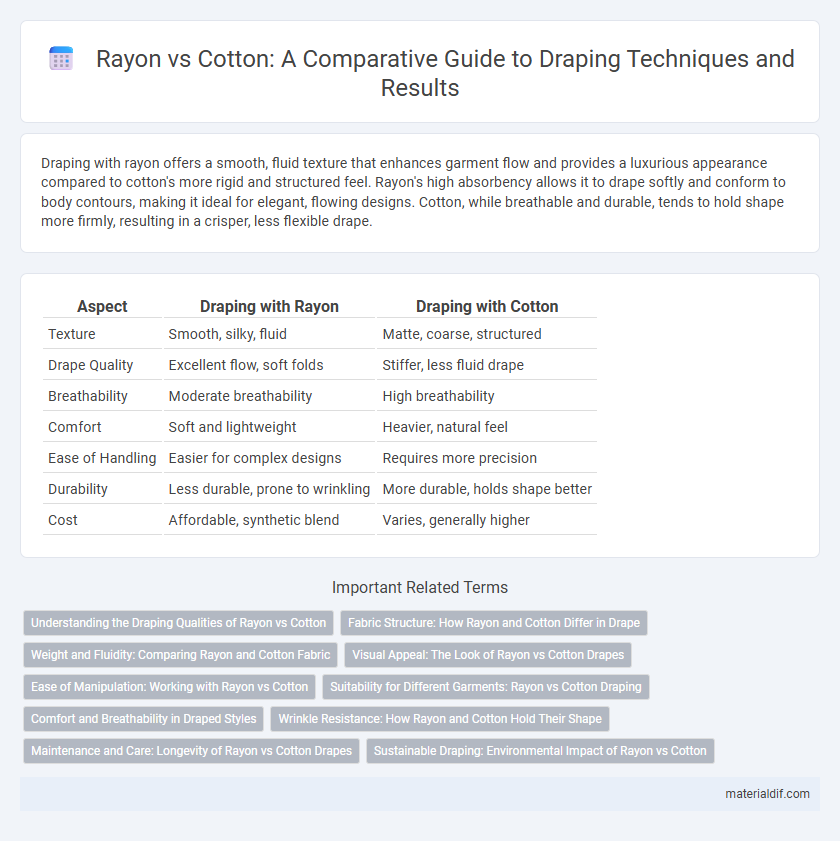Draping with rayon offers a smooth, fluid texture that enhances garment flow and provides a luxurious appearance compared to cotton's more rigid and structured feel. Rayon's high absorbency allows it to drape softly and conform to body contours, making it ideal for elegant, flowing designs. Cotton, while breathable and durable, tends to hold shape more firmly, resulting in a crisper, less flexible drape.
Table of Comparison
| Aspect | Draping with Rayon | Draping with Cotton |
|---|---|---|
| Texture | Smooth, silky, fluid | Matte, coarse, structured |
| Drape Quality | Excellent flow, soft folds | Stiffer, less fluid drape |
| Breathability | Moderate breathability | High breathability |
| Comfort | Soft and lightweight | Heavier, natural feel |
| Ease of Handling | Easier for complex designs | Requires more precision |
| Durability | Less durable, prone to wrinkling | More durable, holds shape better |
| Cost | Affordable, synthetic blend | Varies, generally higher |
Understanding the Draping Qualities of Rayon vs Cotton
Rayon exhibits superior draping qualities compared to cotton due to its smooth, silky texture and higher fluidity, allowing it to flow elegantly over body contours. Cotton, with its stiffer fibers and lower flexibility, tends to create more structured, less fluid drapes that emphasize form rather than flow. Understanding these differences, designers often choose rayon for garments requiring graceful movement and cotton for those demanding firmness and shape retention.
Fabric Structure: How Rayon and Cotton Differ in Drape
Rayon exhibits a smoother, more fluid drape than cotton due to its semi-synthetic cellulose fibers that mimic silk's softness and flexibility. Cotton's natural staple fibers create a stiffer fabric structure, resulting in a more structured and less flowing drape. The longer, continuous filaments in rayon allow it to contour closely to shapes, while cotton's shorter fibers lead to a bulkier, more textured appearance in draped garments.
Weight and Fluidity: Comparing Rayon and Cotton Fabric
Rayon fabric offers superior fluidity and a lighter weight compared to cotton, creating softer and more elegant drapes ideal for flowing garments. Cotton tends to be heavier and stiffer, resulting in a structured drape that holds shape but lacks the silky movement of rayon. The choice between rayon and cotton significantly impacts garment silhouette, with rayon enhancing drape fluidity and cotton providing durability and form.
Visual Appeal: The Look of Rayon vs Cotton Drapes
Rayon drapes exhibit a smooth, lustrous finish that enhances the visual appeal with a subtle sheen absent in cotton drapes. Cotton drapes typically have a matte texture, creating a more casual and natural look compared to the elegant and vibrant appearance of rayon. The fluidity of rayon fabric allows for softer, more graceful folds, while cotton tends to create structured, crisp drapes.
Ease of Manipulation: Working with Rayon vs Cotton
Rayon drapes more fluidly than cotton due to its smooth texture and inherent softness, allowing for effortless folds and elegant silhouettes. Cotton, being stiffer and less pliable, requires more effort to manipulate and shape, often resulting in a more structured and less flowing appearance. The ease of working with rayon makes it a preferred choice for designers seeking graceful movement and delicate draping in garments.
Suitability for Different Garments: Rayon vs Cotton Draping
Rayon drapes fluidly with a smooth, silky texture, making it ideal for garments requiring elegant and flowing silhouettes such as dresses and blouses. Cotton offers a stiffer drape with more structure, which suits tailored garments like shirts and jackets where form and durability are essential. Choosing between rayon and cotton depends on the desired garment style, with rayon favored for softness and movement and cotton preferred for crispness and strength.
Comfort and Breathability in Draped Styles
Rayon offers superior breathability compared to cotton, enhancing comfort in draped styles by allowing better airflow and moisture absorption. Its smooth, lightweight texture drapes fluidly, creating elegant silhouettes without compromising softness against the skin. Cotton, while breathable, tends to be heavier and less fluid, often resulting in stiffer drapes that may limit overall comfort in warm conditions.
Wrinkle Resistance: How Rayon and Cotton Hold Their Shape
Rayon demonstrates superior wrinkle resistance compared to cotton, maintaining its smooth, elegant drape even after extended wear. Cotton tends to crease and lose shape more quickly due to its natural fiber structure, requiring frequent ironing to preserve its appearance. Fabrics made from rayon are often preferred in garments where a polished, wrinkle-free look is essential.
Maintenance and Care: Longevity of Rayon vs Cotton Drapes
Rayon drapes require delicate care, including hand washing or gentle machine cycles with mild detergent to maintain fabric integrity and prevent shrinkage, while cotton drapes are typically more durable and can withstand regular machine washing and higher temperatures. The longevity of rayon drapes depends heavily on proper maintenance to avoid weakening fibers and color fading, whereas cotton drapes tend to retain their strength and appearance longer under standard care practices. Choosing between rayon and cotton drapes involves balancing the softer, more luxurious feel of rayon with its higher maintenance against the robust, low-maintenance nature of cotton.
Sustainable Draping: Environmental Impact of Rayon vs Cotton
Rayon, derived from cellulose fibers, offers sustainable draping benefits compared to conventional cotton due to its lower water consumption and faster biodegradability. While cotton cultivation requires extensive water and pesticide use, viscose rayon production often utilizes renewable wood sources with managed forestry practices, reducing environmental strain. Sustainable draping with rayon minimizes land degradation and supports eco-friendly textile manufacturing, making it a more environmentally responsible choice than traditional cotton fabrics.
Draping with Rayon vs Draping with Cotton Infographic

 materialdif.com
materialdif.com